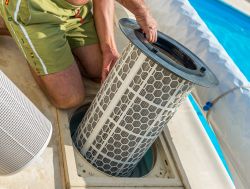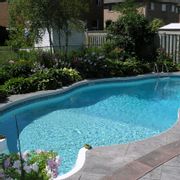
When it comes to keeping your pool clean, three types of filters will get the job done: sand, cartridge, and diatomaceous earth (D.E.). Each pool filter has its own benefits and maintenance requirements to keep it running at maximum efficiency. The informative guide below explores each filter to help you make the right choice for your pool.
3 Types of Pool Filters
1. Sand Filter
Sand filters consist of a tank filled with specially graded sand. The pool pump pulls in water and runs it through the tank, trapping debris between grains of sand. They can pick up particles between 20 to 40 microns in size.
Once the filter reaches capacity, the pressure gauge will indicate an increasing internal pressure, which means it’s time to backwash the filter. Backwashing is a simple process that reverses the water flow of the filter to flush out waste. Keep in mind that repeated backwashing can affect the chemistry and water level of your pool, so you may need to re-balance after cleaning.
The sand will need to be replaced every five to seven years. While sand filters are the lowest in cost, they’re also considered the least effective.
2. Cartridge Filter
 A cartridge filter tank is smaller than a sand one and contains pleated filter media, which capture debris as small as 10 microns. Cleaning is easy, but overall maintenance is a bit more in-depth.
A cartridge filter tank is smaller than a sand one and contains pleated filter media, which capture debris as small as 10 microns. Cleaning is easy, but overall maintenance is a bit more in-depth.
To clean the filter, simply remove the cartridge from the tank and spray it with a hose. Once or twice a year, you’ll need to soak it in filter cleaner to remove oils or a diluted muriatic acid solution to eliminate algae.
These filters cost more upfront, but they’re more efficient in that they waste less water and don’t require you to refill or re-balance the chemicals in your pool. However, they will need to be replaced every two to three years.
3. Diatomaceous Earth (D.E.) Filter
A tank of diatomaceous earth uses filter grids coated in the fossilized remains of diatoms to collect particles as small as 2 to 5 microns. In exchange for its effectiveness, it’s also the most costly and high-maintenance option of the three.
D.E. filters are also cleaned through backwashing. Pool owners will need to hose down or soak each grid to remove grime and debris as well. Some D.E. powder will be lost in the cleaning process, so more must be added after backwashing. Although they can last several years if properly treated, filter grids are expensive to replace.
Whether you need routine pool maintenance or advice on choosing the best pool filter for your needs, turn to M & M Pool Services in Honolulu. Serving all of Oahu, this locally owned and operated company offers comprehensive pool maintenance and cleaning services as well as 24-hour emergency repairs. Call (808) 375-6816 to make an appointment, or visit them online to learn more about their services.
About the Business
Have a question? Ask the experts!
Send your question

